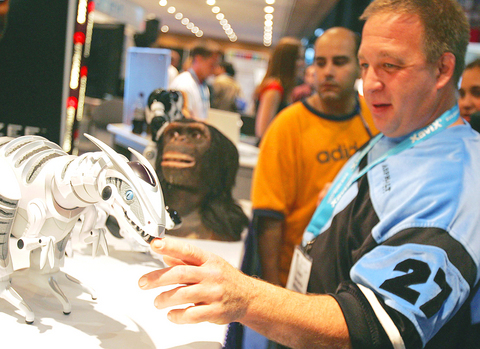At some point in the past 10 years or so -- opinions differ as to exactly when it was -- people working in the British toy industry began to notice something troubling. Toy marketers, perhaps to counterbalance the idea that they spend their days playing, pride themselves on their keen business sense. But now the figures weren't adding up: children were getting less and less interested in toys.
Chrissie Cheshire, a boys' toys buyer for Woolworths, started receiving research reports showing that "kids don't really have toys on the top of their Christmas list from the age of about six these days." They wanted mobile phones and PlayStations instead. "A few years ago, Barbie was sold up to the ages of 10, 11 or 12," said Andy Myall, editor of the industry magazine Toys 'n' Playthings.
"Today, the surveys show that Barbie dolls create massively negative feelings among 10-year-old girls. They think they're childish," he said.

PHOTO: REUTERS
In the US, where the phenomenon has gone the furthest, it is known by the clunky acronym "KAGOY:" Kids Are Getting Older Younger.
To invent a new toy in this climate, you need a peculiar combination of adult commercial savvy and insight into the child brain. Thanks to KAGOY, you really need a toy that isn't a toy: something that can slip through the defenses of resistant children while preferably also appealing to grown-ups too. And you need an idea solid enough to withstand the decidedly unplayful environment of toy retailing, which is currently in a state of open warfare, as dominant market giants like Woolworths and Toys R Us battle to repel advances by supermarkets.
By November last year, Mark Tilden had no way of being certain that he had any of these, but by that time things had gone too far to turn back. At the headquarters of Shing Yue Tooling, a plastic moulding company in Hong Kong, employees were already engaged in repeatedly dropping his robotic dinosaur Roboraptor from a height of exactly 91.4cm, to see if it conformed to safety standards.
"Robotics is usually too serious," Tilden said recently in his company's showroom, in a Hong Kong office complex called Energy Plaza.
"I wanted to make a robot that can kick, walk, fart and burp and do any disgusting things you want, yet still be cute," he said.
Tilden, a bearded giant of a man with an Indiana Jones hat, a mischievous expression and a passion for self-publicity, is a former NASA scientist who describes himself on his business cards as a robotic physicist ("there are only six of us on the planet. It makes for very small conferences"), and so he was well-placed to design Robosapien, a small humanoid capable of walking, picking up objects and throwing them, as well as burping and farting. Robosapien put Tilden's small company, WowWee Toys, on the industry's map and last year, Hamleys, the London toy shop, awarded the robot its prestigious Toy of the Year prize.
"In the 1960s, we were promised that we would one day have flying cars, honeymoons in orbit and robots in our homes. I can't do much about A and B, but I can do C," Tilden said.
NASA "used to give me a million dollars to build one robot to crash on Mars ... Instead, I now make toys for a million children in the hope that they will play with them by themselves," he said.
He came to China in 2002, he is fond of saying, "to work for Santa ... This is the only place in the world where you can build this kind of stuff so that it can be sold for just US$120."
Of course, US$120 is not that cheap for a toy, and during the first few seconds of an initial encounter with Roboraptor -- which is selling in the UK this Christmas for up to ?80 (US$139) -- it is hard not to keep thinking about the price tag. The dinosaur certainly looks striking, its sleek head and bony tail supported by two huge clawed feet, and when you switch it on, it roars impressively. Use the remote control with too much beginner's gusto, though, and it is liable to hobble tentatively before tipping forward on to its chin.
Tilden's contribution to robotics is known as "biomorphics," which involves borrowing the principles of natural evolution to optimize the survivability of his machines. Meeting Roboraptor, though, you begin to wonder how much more quickly real dinosaurs would have become extinct if they had had to contend with carpets.
But then, after maybe half an hour, something changes: you figure out how to put Roboraptor into "guard" mode (in which it will lash out at people who stray too close) and into "playful" mode (in which it will wiggle its tail if you touch it). You discover that if you place something in its mouth, it will try to wrest it away from you, and if you leave it unattended for three minutes, it will spontaneously begin to explore its environment, trundling across the floor until it hits a wall -- which it sometimes, though not always, takes as a reason to start reversing. The urge to anthropomorphize becomes irresistible, which means that when Roboraptor behaves "intelligently" you catch yourself feeling impressed, and when it doesn't, you catch yourself responding as you would to a clumsy toddler, rather than as you ought to respond to an assemblage of 132 plastic parts, 235 metal ones and 191 electrical components.
But Roboraptor is not, primarily, intended to be cute.
"This is the first robot that really has the ability to scare small children," Tilden said proudly. "Our previous robots could annoy your cat.
Roboraptor can hunt him.
"All this is achieved with a radically simple design: The toy's decision-making circuits are modelled on the chip in a musical Christmas card," he said.
Jon Diver's office, in a low-rise brown-brick building in New Malden, Surrey, UK, looks like any other, until you notice the box of My Huggable Scooby-Doo toys in the corner by the heater and the three Little Britain dolls on top of the cupboard. At that point, you realize that the thing you saw moments before, being examined by three men in suits in a glass-fronted office, was almost certainly a Dalek. Character Options, where Diver works, own the rights to distribute Little Britain and Doctor Who.
Diver got a first close look at Roboraptor at the start of the year, at WowWee's exhibition stand in Hong Kong, where he had gone to look for toys in need of a UK distributor. Toy buying involves a several such trips annually, including two to Hong Kong and one to New York, some of which can involve two UK companies flying a long way away in order to hold a meeting with each other.
Roboraptor, Diver could see, had "play." Just as importantly, it appealed to a wide age range. "It's not just four to nine-year-olds, or something like that," Diver said. "You take a Winnie the Pooh, or a Bratz, or a Barbie; it's got a very narrow channel of appeal. The robotics line has an appeal from four to 84."

TRAGEDY STRIKES TAIPEI: The suspect died after falling off a building after he threw smoke grenades into Taipei Main Station and went on a killing spree in Zhongshan A 27-year-old suspect allegedly threw smoke grenades in Taipei Main Station and then proceeded to Zhongshan MRT Station in a random killing spree that resulted in the death of the suspect and two other civilians, and seven injured, including one in critical condition, as of press time last night. The suspect, identified as a man surnamed Chang Wen (張文), allegedly began the attack at Taipei Main Station, the Taipei Fire Department said, adding that it received a report at 5:24pm that smoke grenades had been thrown in the station. One man in his 50s was rushed to hospital after a cardiac arrest

SAFETY FIRST: Double the number of police were deployed at the Taipei Marathon, while other cities released plans to bolster public event safety Authorities across Taiwan have stepped up security measures ahead of Christmas and New Year events, following a knife and smoke bomb attack in Taipei on Friday that left four people dead and 11 injured. In a bid to prevent potential copycat incidents, police deployments have been expanded for large gatherings, transport hubs, and other crowded public spaces, according to official statements from police and city authorities. Taipei Mayor Chiang Wan-an (蔣萬安) said the city has “comprehensively raised security readiness” in crowded areas, increased police deployments with armed officers, and intensified patrols during weekends and nighttime hours. For large-scale events, security checkpoints and explosives

PUBLIC SAFETY: The premier said that security would be tightened in transport hubs, while President Lai commended the public for their bravery The government is to deploy more police, including rapid response units, in crowded public areas to ensure a swift response to any threats, President William Lai (賴清德) said yesterday after a knife attack killed three people and injured 11 in Taipei the previous day. Lai made the remarks following a briefing by the National Police Agency on the progress of the investigation, saying that the attack underscored the importance of cooperation in public security between the central and local governments. The attack unfolded in the early evening on Friday around Taipei Main Station’s M7 exit and later near the Taipei MRT’s Zhongshan

ON ALERT: Taiwan’s partners would issue warnings if China attempted to use Interpol to target Taiwanese, and the global body has mechanisms to prevent it, an official said China has stationed two to four people specializing in Taiwan affairs at its embassies in several democratic countries to monitor and harass Taiwanese, actions that the host nations would not tolerate, National Security Bureau (NSB) Director-General Tsai Ming-yen (蔡明彥) said yesterday. Tsai made the comments at a meeting of the legislature’s Foreign Affairs and National Defense Committee, which asked him and Minister of National Defense Wellington Koo (顧立雄) to report on potential conflicts in the Taiwan Strait and military preparedness. Democratic Progressive Party (DPP) Legislator Michelle Lin (林楚茵) expressed concern that Beijing has posted personnel from China’s Taiwan Affairs Office to its